
Traditional fishing boats
Encyclopedia
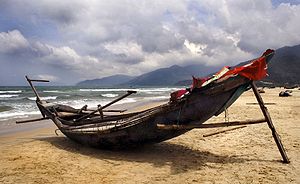
Fishing vessel
A fishing vessel is a boat or ship used to catch fish in the sea, or on a lake or river. Many different kinds of vessels are used in commercial, artisanal and recreational fishing....
to catch fish in the sea, or on a lake or river. Even today, many traditional fishing boats are still in use. According to the United Nations Food and Agriculture Organization
Food and Agriculture Organization
The Food and Agriculture Organization of the United Nations is a specialised agency of the United Nations that leads international efforts to defeat hunger. Serving both developed and developing countries, FAO acts as a neutral forum where all nations meet as equals to negotiate agreements and...
(FAO), at the end of 2004, the world fishing fleet consisted of about 4 million vessels, of which 2.7 million were undecked (open) boats. While nearly all decked vessels were mechanized, only one-third of the undecked fishing boats were powered, usually with outboard engines. The remaining 1.8 million boats were traditional craft of various types, operated by sail and oars.
This article is about the boats used for fishing that are or were built from designs that existed before engines became available.
Overview
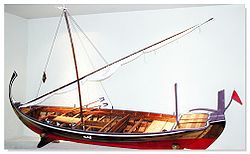
Fishing vessel
A fishing vessel is a boat or ship used to catch fish in the sea, or on a lake or river. Many different kinds of vessels are used in commercial, artisanal and recreational fishing....
s included raft
Raft
A raft is any flat structure for support or transportation over water. It is the most basic of boat design, characterized by the absence of a hull...
s, dugout canoes
Dugout (boat)
A dugout or dugout canoe is a boat made from a hollowed tree trunk. Other names for this type of boat are logboat and monoxylon. Monoxylon is Greek -- mono- + ξύλον xylon -- and is mostly used in classic Greek texts. In Germany they are called einbaum )...
, reed boats, and boats constructed from a frame covered with hide
Hides
A hide is an animal skin treated for human use. Hides include leather from cattle and other livestock animals, alligator skins, snake skins for shoes and fashion accessories and furs from wild cats, mink and bears. In some areas, leather is produced on a domestic or small industrial scale, but most...
or tree bark, such as coracle
Coracle
The coracle is a small, lightweight boat of the sort traditionally used in Wales but also in parts of Western and South Western England, Ireland , and Scotland ; the word is also used of similar boats found in India, Vietnam, Iraq and Tibet...
s. The oldest boats found by archaeological excavation are dugout canoes dating back to the Neolithic Period around 7,000-9,000 years ago. These canoes were often cut from coniferous tree logs, using simple stone tool
Stone tool
A stone tool is, in the most general sense, any tool made either partially or entirely out of stone. Although stone tool-dependent societies and cultures still exist today, most stone tools are associated with prehistoric, particularly Stone Age cultures that have become extinct...
s. A 7000 year-old sea going boat made from reeds and tar has been found in Kuwait. These early vessels had limited capability; they could float and move on water, but were not suitable for use any great distance from the shoreline. They were used mainly for fishing
Fishing
Fishing is the activity of trying to catch wild fish. Fish are normally caught in the wild. Techniques for catching fish include hand gathering, spearing, netting, angling and trapping....
and hunting
Hunting
Hunting is the practice of pursuing any living thing, usually wildlife, for food, recreation, or trade. In present-day use, the term refers to lawful hunting, as distinguished from poaching, which is the killing, trapping or capture of the hunted species contrary to applicable law...
.
The development of fishing boats took place in parallel with the development of boats built for trade and war. Early navigators began to use animal skins or woven fabrics for sail
Sail
A sail is any type of surface intended to move a vessel, vehicle or rotor by being placed in a wind—in essence a propulsion wing. Sails are used in sailing.-History of sails:...
s. Affixed to a pole set upright in the boat, these sails gave early boats more range, allowing voyages of exploration
According to the FAO, at the end of 2004, the world fishing fleet included 1.8 million traditional craft of various types which were operated by sail and oars. These figures for small fishing vessels are probably under reported. The FAO compiles these figures largely from national registers. These records often omit smaller boats where registration is not required or where fishing licences are granted by provincial or municipal authorities. Indonesia
Indonesia
Indonesia , officially the Republic of Indonesia , is a country in Southeast Asia and Oceania. Indonesia is an archipelago comprising approximately 13,000 islands. It has 33 provinces with over 238 million people, and is the world's fourth most populous country. Indonesia is a republic, with an...
reportedly has about 700,000 current fishing boats, 25 percent of which are dugout canoes, and half of which are without motors. The Philippines
Philippines
The Philippines , officially known as the Republic of the Philippines , is a country in Southeast Asia in the western Pacific Ocean. To its north across the Luzon Strait lies Taiwan. West across the South China Sea sits Vietnam...
have reported a similar number of small fishing boats.
Traditional fishing boats are usually characteristic of the stretch of coast along which they operate. They evolve over time to meet the local conditions, such as the materials available locally for boat building, the type of sea conditions the boats will encounter, and the demands of the local fisheries.
Artisan fishing
Artisan fishing
Artisan fishing is a term used to describe small scale low-technology commercial or subsistence fishing practices. The term particularly applies to coastal or island ethnic groups using traditional techniques such as rod and tackle, arrows and harpoons, throw nets and drag nets, and traditional...
is a term used to describe small scale commercial
Commercial fishing
Commercial fishing is the activity of catching fish and other seafood for commercial profit, mostly from wild fisheries. It provides a large quantity of food to many countries around the world, but those who practice it as an industry must often pursue fish far into the ocean under adverse conditions...
or subsistence fishing practises. The term particularly applies to coastal or island ethnic groups using traditional fishing techniques
Fishing techniques
Fishing techniques are methods for catching fish. The term may also be applied to methods for catching other aquatic animals such as molluscs and edible marine invertebrates....
and traditional boats. The term can also be applied to heritage groups involved in customary fishing practices. Small traditional fishing boats are usually used by artisan fishers
Artisan fishing
Artisan fishing is a term used to describe small scale low-technology commercial or subsistence fishing practices. The term particularly applies to coastal or island ethnic groups using traditional techniques such as rod and tackle, arrows and harpoons, throw nets and drag nets, and traditional...
. Artisan fishing boats are often open (undecked), many have sails, but they do not usually use much, or any mechanised or electronic gear. Large numbers of artisan fishing boats are still in use, particularly in developing countries with long productive marine coastlines.
Rafts
A raftRaft
A raft is any flat structure for support or transportation over water. It is the most basic of boat design, characterized by the absence of a hull...
is a structure with a flat top that floats. It is the most basic boat design, characterized by the absence of a hull. The classic raft is constructed by lashing several logs, placed side by side, to two or more additional logs placed transverse to the others. In many Asian countries, the rafts are similarly constructed using bamboo.
In shallow waters, rafts can be punted with a push pole. They can be used as stealthy platforms for fishing shallow waters around lakes. In sheltered coastal waters, anchored or drifting rafts can become effective fish aggregating devices. Payaos
Payaos
A payaos is a type of fish aggregating device used in Southeast Asia, particularly in the Philippines. Payaos were traditionally bamboo rafts for handline fishing before World War II, but modern steel payaos use fish lights and fish location sonar to increase yields...
were traditional bamboo rafts used in Southeast Asia
Southeast Asia
Southeast Asia, South-East Asia, South East Asia or Southeastern Asia is a subregion of Asia, consisting of the countries that are geographically south of China, east of India, west of New Guinea and north of Australia. The region lies on the intersection of geological plates, with heavy seismic...
as aggregating device. Fishermen on the top of the raft used handlines to catch tuna
Tuna
Tuna is a salt water fish from the family Scombridae, mostly in the genus Thunnus. Tuna are fast swimmers, and some species are capable of speeds of . Unlike most fish, which have white flesh, the muscle tissue of tuna ranges from pink to dark red. The red coloration derives from myoglobin, an...
.
Pontoon boats, and to some degree the punt
Punt (boat)
A punt is a flat-bottomed boat with a square-cut bow, designed for use in small rivers or other shallow water. Punting refers to boating in a punt. The punter generally propels the punt by pushing against the river bed with a pole...
, can be viewed as modern derivatives of rafts.
Reed boats
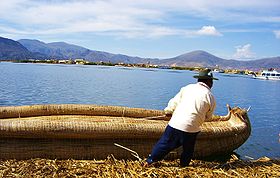

The earliest known boat made with reeds (and tar) is a 7000 year-old sea going boat found in Kuwait.
The Uros
Uros
The Uros are a pre-Incan people who live on forty-two self-fashioned floating islands in Lake Titicaca Puno, Peru and Bolivia. They form three main groups: Uru-Chipayas, Uru-Muratos and the Uru-Iruitos...
are an indigenous people pre-dating the Incas. They live, still today, on man-made floating islands scattered across Lake Titicaca
Lake Titicaca
Lake Titicaca is a lake located on the border of Peru and Bolivia. It sits 3,811 m above sea level, making it the highest commercially navigable lake in the world...
. These islands are constructed from totora reeds
Totora (plant)
Totora is a subspecies of the giant bulrush sedge. It is found in South America - notably on Lake Titicaca, the middle coast of Perú and on Easter Island in the Pacific Ocean...
. Lake Titicaca, part belonging to Bolivia
Bolivia
Bolivia officially known as Plurinational State of Bolivia , is a landlocked country in central South America. It is the poorest country in South America...
and the rest to Peru
Peru
Peru , officially the Republic of Peru , is a country in western South America. It is bordered on the north by Ecuador and Colombia, on the east by Brazil, on the southeast by Bolivia, on the south by Chile, and on the west by the Pacific Ocean....
, is 3810 meters above sea level. Each floating island supports between three and ten houses, also built of reeds. The Uros also build their boats from bundled dried reeds. These days some Uros boats, used for fishing and hunting seabirds, have motors.
Reed boats were constructed in Easter Island
Easter Island
Easter Island is a Polynesian island in the southeastern Pacific Ocean, at the southeasternmost point of the Polynesian triangle. A special territory of Chile that was annexed in 1888, Easter Island is famous for its 887 extant monumental statues, called moai, created by the early Rapanui people...
with a markedly similar design to those used in Peru. Apart from Peru and Bolivia, reed boats are still used in Ethiopia
Ethiopia
Ethiopia , officially known as the Federal Democratic Republic of Ethiopia, is a country located in the Horn of Africa. It is the second-most populous nation in Africa, with over 82 million inhabitants, and the tenth-largest by area, occupying 1,100,000 km2...
and were used until recently in Corfu
Corfu
Corfu is a Greek island in the Ionian Sea. It is the second largest of the Ionian Islands, and, including its small satellite islands, forms the edge of the northwestern frontier of Greece. The island is part of the Corfu regional unit, and is administered as a single municipality. The...
.
Coracles
Coracles are light boats shaped like a bowl, typically with a frame of woven grass or reeds, or strong saplings covered with animal hides. The keelKeel
In boats and ships, keel can refer to either of two parts: a structural element, or a hydrodynamic element. These parts overlap. As the laying down of the keel is the initial step in construction of a ship, in British and American shipbuilding traditions the construction is dated from this event...
-less, flat bottom evenly spreads the weight across the structure reducing the required depth of water often to only a few inches. Coracles have been used, and to a degree are still used, in India, Vietnam, Iraq, Tibet, North America and Britain.
Coracles in Iraq
Iraq
Iraq ; officially the Republic of Iraq is a country in Western Asia spanning most of the northwestern end of the Zagros mountain range, the eastern part of the Syrian Desert and the northern part of the Arabian Desert....
are called quffa. Their history goes back to antiquity where they appear on sculptured panels in Assyrian palaces constructed between 700 and 900 BC. These panels are now in the British Museum
British Museum
The British Museum is a museum of human history and culture in London. Its collections, which number more than seven million objects, are amongst the largest and most comprehensive in the world and originate from all continents, illustrating and documenting the story of human culture from its...
. Herodotus
Herodotus
Herodotus was an ancient Greek historian who was born in Halicarnassus, Caria and lived in the 5th century BC . He has been called the "Father of History", and was the first historian known to collect his materials systematically, test their accuracy to a certain extent and arrange them in a...
visited Babylon in the 5th century BC, and wrote a long description of the coracles he encountered there. Traditionally, quffa were framed with willow
Willow
Willows, sallows, and osiers form the genus Salix, around 400 species of deciduous trees and shrubs, found primarily on moist soils in cold and temperate regions of the Northern Hemisphere...
or juniper
Juniper
Junipers are coniferous plants in the genus Juniperus of the cypress family Cupressaceae. Depending on taxonomic viewpoint, there are between 50-67 species of juniper, widely distributed throughout the northern hemisphere, from the Arctic, south to tropical Africa in the Old World, and to the...
and covered with hides. The outside was coated with hot bitumen for waterproofing. These coracles have been in use, at least until recently, around Baghdad
Baghdad
Baghdad is the capital of Iraq, as well as the coterminous Baghdad Governorate. The population of Baghdad in 2011 is approximately 7,216,040...
and on the Tigris
Tigris
The Tigris River is the eastern member of the two great rivers that define Mesopotamia, the other being the Euphrates. The river flows south from the mountains of southeastern Turkey through Iraq.-Geography:...
. Some of the Iraq coracles are very large.
Coracles are known to have been in use in Britain in 49BC when Julius Caesar
Julius Caesar
Gaius Julius Caesar was a Roman general and statesman and a distinguished writer of Latin prose. He played a critical role in the gradual transformation of the Roman Republic into the Roman Empire....
encountered them. They are still used in Wales
Wales
Wales is a country that is part of the United Kingdom and the island of Great Britain, bordered by England to its east and the Atlantic Ocean and Irish Sea to its west. It has a population of three million, and a total area of 20,779 km²...
, where they were traditionally framed with split and interwoven willow
Willow
Willows, sallows, and osiers form the genus Salix, around 400 species of deciduous trees and shrubs, found primarily on moist soils in cold and temperate regions of the Northern Hemisphere...
rods, tied with willow bark. The outer layer was an animal skin, such as horse
Horse
The horse is one of two extant subspecies of Equus ferus, or the wild horse. It is a single-hooved mammal belonging to the taxonomic family Equidae. The horse has evolved over the past 45 to 55 million years from a small multi-toed creature into the large, single-toed animal of today...
or bullock
Cattle
Cattle are the most common type of large domesticated ungulates. They are a prominent modern member of the subfamily Bovinae, are the most widespread species of the genus Bos, and are most commonly classified collectively as Bos primigenius...
hide, with a thin layer of tar
Tar
Tar is modified pitch produced primarily from the wood and roots of pine by destructive distillation under pyrolysis. Production and trade in tar was a major contributor in the economies of Northern Europe and Colonial America. Its main use was in preserving wooden vessels against rot. The largest...
for water proofing. Today tarred calico or canvas
Canvas
Canvas is an extremely heavy-duty plain-woven fabric used for making sails, tents, marquees, backpacks, and other items for which sturdiness is required. It is also popularly used by artists as a painting surface, typically stretched across a wooden frame...
, or simply fibreglass can be used. Different Welsh rivers have their own designs, tailored to the flow of the river. The Teifi coracle
River Teifi
The River Teifi forms the boundary between the counties of Ceredigion and Carmarthenshire in south-west Wales for most of its 75 mile length, flowing into the sea below the town of Cardigan. The catchment of the river is estimated to be 1,008 square kilometres yielding an average flow at Glan...
, for instance, is flat bottomed, as it is designed to negotiate shallow rapids, common on the river in the summer, while the Carmarthen
Carmarthen
Carmarthen is a community in, and the county town of, Carmarthenshire, Wales. It is sited on the River Towy north of its mouth at Carmarthen Bay. In 2001, the population was 14,648....
coracle is rounder and deeper, because it is used in tidal waters on the Tywi
River Tywi
With a total length of the River Towy is the longest river flowing entirely within Wales, and is noted for its sea trout and salmon fishing.The river rises within of the Teifi on the lower slopes of Crug Gynan in the Cambrian Mountains and, flowing through the Towy Forest, forms the border...
, where there are no rapids.
Coracles can be effective fishing vessels. When operated skilfully, they hardly disturb the water or the fish. Welsh coracle fishing is performed by two men, each seated in his coracle and with one hand holding the net while with the other he plies his paddle. When a fish is caught, each hauls up his end of the net until the two coracles touch and the fish are secured. Many coracles are so light and portable that they can easily be carried on the fisherman's shoulders.
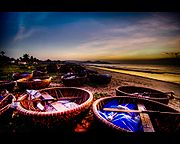
Tibet
Tibet is a plateau region in Asia, north-east of the Himalayas. It is the traditional homeland of the Tibetan people as well as some other ethnic groups such as Monpas, Qiang, and Lhobas, and is now also inhabited by considerable numbers of Han and Hui people...
, coracles, used for fishing and ferrying people, are made by stretching yak hide
Yak
The yak, Bos grunniens or Bos mutus, is a long-haired bovine found throughout the Himalayan region of south Central Asia, the Tibetan Plateau and as far north as Mongolia and Russia. In addition to a large domestic population, there is a small, vulnerable wild yak population...
over juniper
Juniper
Junipers are coniferous plants in the genus Juniperus of the cypress family Cupressaceae. Depending on taxonomic viewpoint, there are between 50-67 species of juniper, widely distributed throughout the northern hemisphere, from the Arctic, south to tropical Africa in the Old World, and to the...
frames, and fastened with leather thongs. They are shaped like the Iraq coracles. Yack butter is used for waterproofing. Again, different rivers have their own designs. Sometimes two coracles are strapped together for added stability.
In North America, American Indians
Indigenous peoples of the Americas
The indigenous peoples of the Americas are the pre-Columbian inhabitants of North and South America, their descendants and other ethnic groups who are identified with those peoples. Indigenous peoples are known in Canada as Aboriginal peoples, and in the United States as Native Americans...
and frontiersmen made coracles, called bull boat
Bull Boat
A Bull Boat is a small boat, usually made by American Indians and frontiersmen, made by covering a skeletal wooden frame with a buffalo hide.When traders of Hudson's Bay Company first visited the Mandan Indians in 1790 they found that tribe possessed of tublike boats with framework of willow poles,...
s, by covering a willow
Willow
Willows, sallows, and osiers form the genus Salix, around 400 species of deciduous trees and shrubs, found primarily on moist soils in cold and temperate regions of the Northern Hemisphere...
frame with buffalo
American Bison
The American bison , also commonly known as the American buffalo, is a North American species of bison that once roamed the grasslands of North America in massive herds...
hide. The buffalo hair was left on the hide because it inhibited the craft from spinning, and the tails were also left intact and used to tie bull boats together.
Indian coracles
Indian coracles
Indian coracles are commonly found on the rivers Kaveri and Tungabhadra in Southern India. Coracles are primitive, light, bowl-shaped boats with a frame of woven grasses, reeds, or saplings covered with hides. Indian coracles are considered to have been in existence since prehistoric times, and...
commonly operate on the rivers Kaveri and Tungabhadra in Southern India
South India
South India is the area encompassing India's states of Andhra Pradesh, Karnataka, Kerala and Tamil Nadu as well as the union territories of Lakshadweep and Pondicherry, occupying 19.31% of India's area...
. The smaller ones are about 6.2 feet (1.9 metres) in diameter, and are used primarily for fishing. Indian coracles have been used since prehistoric times.
In Vietnam
Vietnam
Vietnam – sometimes spelled Viet Nam , officially the Socialist Republic of Vietnam – is the easternmost country on the Indochina Peninsula in Southeast Asia. It is bordered by China to the north, Laos to the northwest, Cambodia to the southwest, and the South China Sea –...
, elegant coracles constructed with bamboo, are still used from many beaches, such as at Nha Trang
Nha Trang
Nha Trang is a coastal city and capital of Khanh Hoa province, on the South Central Coast of Vietnam. It is bounded on the North by Ninh Hoà district, on the East by the South China Sea, on the South by Cam Ranh town and on the West by Diên Khánh district...
, Phan Thiết
Phan Thiết
Phan Thiết town is the capital of Binh Thuan province, in southeastern Vietnam. Phan Thiet is a municipality in central, south central sector, however, the development plan to 2025, it would be municipality Southeast Vietnam. The population of Phan Thiết city in 2005 is roughly 350,000 and is...
and Mui Ne
Mui Ne
Mui Ne is a coastal resort town in the Binh Thuan Province of southeastern Vietnam. The town is close to the city of Phan Thiết. Tourism has transformed Mui Ne into a resort destination since 1995, when many visited to view the total solar eclipse of October 24, 1995. Mui Ne has many resorts on...
. The coracles are towed in a line behind a motor boat, like beads on a string, to their fishing ground. There the fisherman lay fishing nets in the sea before another tow returns them with their catch.
Canoes
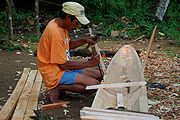
Canoe
A canoe or Canadian canoe is a small narrow boat, typically human-powered, though it may also be powered by sails or small electric or gas motors. Canoes are usually pointed at both bow and stern and are normally open on top, but can be decked over A canoe (North American English) or Canadian...
is a small narrow boat, usually pointed at both bow and stern and normally open on top, though they can be covered. A dugout is a canoe hollowed from a tree trunk. The oldest known canoe is the dugout canoe
Dugout (boat)
A dugout or dugout canoe is a boat made from a hollowed tree trunk. Other names for this type of boat are logboat and monoxylon. Monoxylon is Greek -- mono- + ξύλον xylon -- and is mostly used in classic Greek texts. In Germany they are called einbaum )...
of Pesse
Hoogeveen
Hoogeveen is a municipality and a town in the northeastern Netherlands.- Population centres :Elim, Fluitenberg, Hoogeveen and Noordscheschut, which still have the canals which used to be throughout the town...
(the Netherlands). According to C14 dating
Radiocarbon dating
Radiocarbon dating is a radiometric dating method that uses the naturally occurring radioisotope carbon-14 to estimate the age of carbon-bearing materials up to about 58,000 to 62,000 years. Raw, i.e. uncalibrated, radiocarbon ages are usually reported in radiocarbon years "Before Present" ,...
analysis it was constructed somewhere between 8200 and 7600 BC. This canoe is exhibited in the Drents Museum in Assen
Assen
Assen is a municipality and a city in the north eastern Netherlands, capital of the province of Drenthe. It received city rights in 1809. Assen's main claim to fame is the TT Circuit Assen the motorcycle racing circuit, where on the last Saturday in June the Dutch TT is run...
, Netherlands. Another dugout, almost as old, has been found at Noyen-sur-Seine
Noyen-sur-Seine
Noyen-sur-Seine is a commune in the Seine-et-Marne department in the Île-de-France region in north-central France.-External links:* * *...
. The oldest known canoe found in Africa is the Dufuna canoe
Dufuna canoe
Dufuna canoe is a 8000 year old canoe discovered by Fulani herdsman in Nigeria in 1987.. It is the oldest boat to be discovered in Africa, and the third oldest known worldwide....
, constructed about 6000 BC. It was discovered by Fulani herdsman in Nigeria
Nigeria
Nigeria , officially the Federal Republic of Nigeria, is a federal constitutional republic comprising 36 states and its Federal Capital Territory, Abuja. The country is located in West Africa and shares land borders with the Republic of Benin in the west, Chad and Cameroon in the east, and Niger in...
in 1987.
During the Iron Age
Iron Age
The Iron Age is the archaeological period generally occurring after the Bronze Age, marked by the prevalent use of iron. The early period of the age is characterized by the widespread use of iron or steel. The adoption of such material coincided with other changes in society, including differing...
residents of Great Britain
Great Britain
Great Britain or Britain is an island situated to the northwest of Continental Europe. It is the ninth largest island in the world, and the largest European island, as well as the largest of the British Isles...
used dugouts for fishing and transport. Two ancient dugouts discovered in Newport, Shropshire
Newport, Shropshire
Newport is a market town in the borough of Telford and Wrekin and ceremonial county of Shropshire, England. It lies some north of Telford and some west of Stafford sitting on the Shropshire/Staffordshire border...
are on display at Harper Adams University College
Harper Adams University College
Harper Adams University College is a higher education institution located close to the village of Edgmond , in Shropshire, England. It is the UK's leading specialist provider of higher education for the agri-food chain and rural sector....
Newport. In 1964, a dugout was uncovered in Poole Harbour
Poole Harbour
Poole Harbour is a large natural harbour in Dorset, southern England, with the town of Poole on its shores. The harbour is a drowned valley formed at the end of the last ice age and is the estuary of several rivers, the largest being the Frome. The harbour has a long history of human settlement...
, Dorset
Dorset
Dorset , is a county in South West England on the English Channel coast. The county town is Dorchester which is situated in the south. The Hampshire towns of Bournemouth and Christchurch joined the county with the reorganisation of local government in 1974...
. The Poole Logboat
Poole Logboat
The Poole Logboat is an ancient logboat made from a single oak tree. It was excavated in the town of Poole, Dorset, England. The boat is over 2,200 years old and is estimated through carbon dating to have been constructed around 300–200 BCE. The Iron Age vessel was unearthed in 1964 during dredging...
, dated to 300 BC, was large enough to accommodate 18 people and was constructed from a large oak tree
Oak Tree
Oak Tree may refer to:*Oak, the tree*Oak Tree, County Durham, a village in County Durham, England*The Oaktree Foundation, a youth-run aid and development agency*Oak Tree National, golf club in Edmond, Oklahoma...
.
Best known are the canoes of the Eastern North American Indians. These, often elegant canoes, were not dugouts, but were made of a wooden frame covered with bark of a birch tree
Birch bark
Birch bark or birchbark is the bark of several Eurasian and North American birch trees of the genus Betula.The strong and water-resistant cardboard-like bark can be easily cut, bent, and sewn, which made it a valuable building, crafting, and writing material, since pre-historic times...
, pitched
Pitch (resin)
Pitch is the name for any of a number of viscoelastic, solid polymers. Pitch can be made from petroleum products or plants. Petroleum-derived pitch is also called bitumen. Pitch produced from plants is also known as resin. Products made from plant resin are also known as rosin.Pitch was...
to make it waterproof.


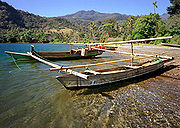
Paddle
A paddle is a tool used for pushing against liquids, either as a form of propulsion in a boat or as an implement for mixing.-Materials and designs:...
s, often with two people. Paddlers face in the direction of travel, either seated on supports in the hull, or kneeling directly upon the hull. Paddles can be single-bladed or double-bladed.
A pirogue
Pirogue
A pirogue is a small, flat-bottomed boat of a design associated particularly with the Cajuns of the Louisiana marsh. In West Africa they were used as traditional fishing boats. These boats are not usually intended for overnight travel but are light and small enough to be easily taken onto land...
is a small, flat-bottomed boat of a design associated particularly with West Africa
West Africa
West Africa or Western Africa is the westernmost region of the African continent. Geopolitically, the UN definition of Western Africa includes the following 16 countries and an area of approximately 5 million square km:-Flags of West Africa:...
n fishermen
Fisherman
A fisherman or fisher is someone who captures fish and other animals from a body of water, or gathers shellfish. Worldwide, there are about 38 million commercial and subsistence fishermen and fish farmers. The term can also be applied to recreational fishermen and may be used to describe both men...
and the Cajun
Cajun
Cajuns are an ethnic group mainly living in the U.S. state of Louisiana, consisting of the descendants of Acadian exiles...
s of the Louisiana
Louisiana
Louisiana is a state located in the southern region of the United States of America. Its capital is Baton Rouge and largest city is New Orleans. Louisiana is the only state in the U.S. with political subdivisions termed parishes, which are local governments equivalent to counties...
marsh. These are usually dugouts, and are light and small enough to be easily taken onto land. The design allows the pirogue to move through the very shallow water of marshes and be easily turned over to drain any water that may get into the boat. The pirogue is usually propelled by paddles with one blade. It can also be punted with a push pole in shallow water. Small sail
Sail
A sail is any type of surface intended to move a vessel, vehicle or rotor by being placed in a wind—in essence a propulsion wing. Sails are used in sailing.-History of sails:...
s can also be used. Outboard motors are increasingly being used in many regions.
The log canoe
Log canoe
The log canoe is a type of sailboat developed in the Chesapeake Bay region. Based on the dugout, it was the principal traditional fishing boat of the bay until superseded by the bugeye and the skipjack. However, it is most famous as a racing sailboat, and races continue to be held.The history of...
of Chesapeake Bay
Chesapeake Bay
The Chesapeake Bay is the largest estuary in the United States. It lies off the Atlantic Ocean, surrounded by Maryland and Virginia. The Chesapeake Bay's drainage basin covers in the District of Columbia and parts of six states: New York, Pennsylvania, Delaware, Maryland, Virginia, and West...
is in the modern sense not a canoe at all, though it evolved through the enlargement of dugout
Dugout (boat)
A dugout or dugout canoe is a boat made from a hollowed tree trunk. Other names for this type of boat are logboat and monoxylon. Monoxylon is Greek -- mono- + ξύλον xylon -- and is mostly used in classic Greek texts. In Germany they are called einbaum )...
canoes.
For stability in rougher waters, canoes can be fitted with outrigger
Outrigger
An outrigger is a part of a boat's rigging which is rigid and extends beyond the side or gunwale of a boat.In an outrigger canoe and in sailboats such as the proa, an outrigger is a thin, long, solid, hull used to stabilise an inherently unstable main hull. The outrigger is positioned rigidly and...
s. One or two small logs are mounted parallel to the main hull by long poles. In the case of two outriggers, one is mounted to either side of the hull. These are called outrigger canoe
Outrigger canoe
The outrigger canoe is a type of canoe featuring one or more lateral support floats known as outriggers, which are fastened to one or both sides of the main hull...
s.
Many of the fishing boats in Indonesia and the Philippines are double-outrigger craft, consisting of a narrow main hull with two attached outriggers, commonly known as jukung
Jukung
A jukung or canoe is a small wooden Indonesian boat. It is a traditional fishing boat, but newer uses include "Jukung Dives", using the boat as a vehicle for small groups of SCUBA divers...
in Indonesia and banca in the Philippines.
The jukung
Jukung
A jukung or canoe is a small wooden Indonesian boat. It is a traditional fishing boat, but newer uses include "Jukung Dives", using the boat as a vehicle for small groups of SCUBA divers...
is of Balinese
Balinese people
The Balinese population of 3.0 million live mostly on the island of Bali, making up 89% of the island's population. There are also significant populations on the island of Lombok, and in the eastern-most regions of Java The Balinese population of 3.0 million (1.5% of Indonesia's population) live...
origin, one of many genre of Pacific/Asian outrigger canoes. The considerable stability provided by the outriggers means that the jukung copes well with a lateen
Lateen
A lateen or latin-rig is a triangular sail set on a long yard mounted at an angle on the mast, and running in a fore-and-aft direction....
(triangular) sail. While the lateen sail presents some difficulties in tacking
Tacking (sailing)
Tacking or coming about is a sailing maneuver by which a sailing vessel turns its bow through the wind so that the direction from which the wind blows changes from one side to the other...
into the wind, requiring a jibe
Jibe
A jibe or gybe is a sailing maneuver where a sailing vessel turns its stern through the wind, such that the wind direction changes from one side of the boat to the other...
, the jukung is superb in its reaching ability and jybe-safe running. They are usually highly decorated and bear a marlin-like prow
Prow
thumb|right|295pxThe prow is the forward most part of a ship's bow that cuts through the water. The prow is the part of the bow above the waterline. The terms prow and bow are often used interchangeably to describe the most forward part of a ship and its surrounding parts...
.
A traditional catamaran
Catamaran
A catamaran is a type of multihulled boat or ship consisting of two hulls, or vakas, joined by some structure, the most basic being a frame, formed of akas...
consists of two canoes, or vaka
Vaka (sailing)
The vaka is the main hull of a multihull vessel.-Origin and use of the term:The term vaka is used in the Polynesian, Malay and Micronesian languages for a 'canoe', 'ship' or 'boat.' Other parts of a traditional vaka can include the aka and ama .A proa consists of a vaka, the main canoe-like...
s, joined by a frame, formed of aka
Aka (sailing)
The aka of a multihull sailboat is a member of the framework that connects the hull to the ama . The term aka originated with the proa, but is also applied to modern trimarans....
s. Catamarans were used by the ancient Tamil Chola dynasty
Chola Dynasty
The Chola dynasty was a Tamil dynasty which was one of the longest-ruling in some parts of southern India. The earliest datable references to this Tamil dynasty are in inscriptions from the 3rd century BC left by Asoka, of Maurya Empire; the dynasty continued to govern over varying territory until...
as early as the 5th century AD for moving their invasion fleets. Since then, they have been widely used for fishing in South East Asia and Polynesia.
Kayak
Kayak
A kayak is a small, relatively narrow, human-powered boat primarily designed to be manually propelled by means of a double blade paddle.The traditional kayak has a covered deck and one or more cockpits, each seating one paddler...
s are generally differentiated from canoes by the sitting position of the paddler and the number of blades on the paddle. In a kayak the paddler faces forward, legs in front, using a double bladed paddle. In a canoe the paddler faces forward and sits or kneels in the boat, using a single bladed paddle. In some parts of the world, such as the United Kingdom
United Kingdom
The United Kingdom of Great Britain and Northern IrelandIn the United Kingdom and Dependencies, other languages have been officially recognised as legitimate autochthonous languages under the European Charter for Regional or Minority Languages...
, kayaks are considered a subtype of canoe
Canoe
A canoe or Canadian canoe is a small narrow boat, typically human-powered, though it may also be powered by sails or small electric or gas motors. Canoes are usually pointed at both bow and stern and are normally open on top, but can be decked over A canoe (North American English) or Canadian...
s. Continental European and British
United Kingdom
The United Kingdom of Great Britain and Northern IrelandIn the United Kingdom and Dependencies, other languages have been officially recognised as legitimate autochthonous languages under the European Charter for Regional or Minority Languages...
canoeing clubs and associations of the 19th Century used craft similar to kayaks, but referred to them as canoes.
Ropes and lines
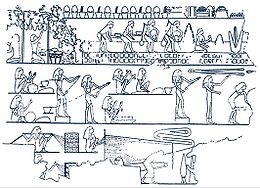
Rope
A rope is a length of fibres, twisted or braided together to improve strength for pulling and connecting. It has tensile strength but is too flexible to provide compressive strength...
s and lines are made of fibre lengths, twisted or braid
Braid
A braid is a complex structure or pattern formed by intertwining three or more strands of flexible material such as textile fibres, wire, or human hair...
ed together to provide tensile strength. They are used for pulling, but not for pushing.
Fossil
Fossil
Fossils are the preserved remains or traces of animals , plants, and other organisms from the remote past...
ised fragments of "probably two-ply laid rope of about 7 mm diameter" have been found in one of the caves at Lascaux
Lascaux
Lascaux is the setting of a complex of caves in southwestern France famous for its Paleolithic cave paintings. The original caves are located near the village of Montignac, in the department of Dordogne. They contain some of the best-known Upper Paleolithic art. These paintings are estimated to be...
, dated about 15,000 BC. Egyptian rope dates back to 4000 to 3500 BC and was generally made of water reed fibers. Other rope in antiquity was made from the fibers of date palm
Date Palm
The date palm is a palm in the genus Phoenix, cultivated for its edible sweet fruit. Although its place of origin is unknown because of long cultivation, it probably originated from lands around the Persian Gulf. It is a medium-sized plant, 15–25 m tall, growing singly or forming a clump with...
s, flax
Flax
Flax is a member of the genus Linum in the family Linaceae. It is native to the region extending from the eastern Mediterranean to India and was probably first domesticated in the Fertile Crescent...
, grass
Grass
Grasses, or more technically graminoids, are monocotyledonous, usually herbaceous plants with narrow leaves growing from the base. They include the "true grasses", of the Poaceae family, as well as the sedges and the rushes . The true grasses include cereals, bamboo and the grasses of lawns ...
, papyrus
Papyrus
Papyrus is a thick paper-like material produced from the pith of the papyrus plant, Cyperus papyrus, a wetland sedge that was once abundant in the Nile Delta of Egypt....
, leather
Leather
Leather is a durable and flexible material created via the tanning of putrescible animal rawhide and skin, primarily cattlehide. It can be produced through different manufacturing processes, ranging from cottage industry to heavy industry.-Forms:...
, or animal hair. Rope made of hemp
Hemp
Hemp is mostly used as a name for low tetrahydrocannabinol strains of the plant Cannabis sativa, of fiber and/or oilseed varieties. In modern times, hemp has been used for industrial purposes including paper, textiles, biodegradable plastics, construction, health food and fuel with modest...
fibres was in use in China from about 2800 BC.
The availability of reliable and durable ropes and lines has had many consequences for the development and utility of traditional fishing boats. They can be used to lash planks and frames together, as stay lines for masts, as anchor lines to secure the boat, and as fishing line
Fishing line
A fishing line is a cord used or made for angling. Important parameters of a fishing line are its length, material, and weight...
s for making fishing net
Fishing net
A fishing net or fishnet is a net that is used for fishing. Fishing nets are meshes usually formed by knotting a relatively thin thread. Modern nets are usually made of artificial polyamides like nylon, although nets of organic polyamides such as wool or silk thread were common until recently and...
s.
Propulsion

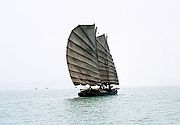
Sail
A sail is any type of surface intended to move a vessel, vehicle or rotor by being placed in a wind—in essence a propulsion wing. Sails are used in sailing.-History of sails:...
s to masts
Mast (sailing)
The mast of a sailing vessel is a tall, vertical, or near vertical, spar, or arrangement of spars, which supports the sails. Large ships have several masts, with the size and configuration depending on the style of ship...
set upright in the boat. Manual propulsion could be done in shallow water by punting with a push pole, and in deeper water by paddling
Watercraft paddling
Paddling with regard to watercraft is the act of manually propelling or navigating a small boat using a blade that is joined to a shaft, known as paddle, in the water. The paddle is also used to steer the vessel and may either be a single bladed or double bladed...
with a paddle
Paddle
A paddle is a tool used for pushing against liquids, either as a form of propulsion in a boat or as an implement for mixing.-Materials and designs:...
or rowing with oar
Oar
An oar is an implement used for water-borne propulsion. Oars have a flat blade at one end. Oarsmen grasp the oar at the other end. The difference between oars and paddles are that paddles are held by the paddler, and are not connected with the vessel. Oars generally are connected to the vessel by...
s. The difference between paddling and rowing is that when rowing the oars have a mechanical connection with the boat, while when paddling the paddles are hand-held with no mechanical connection. Canoes were traditionally paddled, with the paddler facing the bow of the boat. Small boats that use oars are called rowboats, and the rower typically faces the stern.
Around 4000 B.C., Egyptians
Ancient Egypt
Ancient Egypt was an ancient civilization of Northeastern Africa, concentrated along the lower reaches of the Nile River in what is now the modern country of Egypt. Egyptian civilization coalesced around 3150 BC with the political unification of Upper and Lower Egypt under the first pharaoh...
were building long narrow boats powered by many oarsmen. Over the next 1,000 years, they made a series of remarkable advances in boat design. They developed cotton-made sails to help their boats go faster with less work. Then they built boats large enough to cross the oceans. These boats had sails and oarsmen, and were used for war and trade. Some ancient vessels were propelled by either oars or sail, depending on the speed and direction of the wind (see trireme
Trireme
A trireme was a type of galley, a Hellenistic-era warship that was used by the ancient maritime civilizations of the Mediterranean, especially the Phoenicians, ancient Greeks and Romans.The trireme derives its name from its three rows of oars on each side, manned with one man per oar...
and bireme
Bireme
A bireme is an ancient Hellenistic-era warship with two decks of oars, probably invented by the Phoenicians. It typically was about long with a maximum beam width of around . It was modified from the penteconter, a ship that had only one set of oars on each side, the bireme having two sets of oars...
). The Chinese were using sails around 3000 BC, of a type that can still be seen on traditional fishing boats sailing off the coast of Vietnam in Ha Long Bay.
A jangada
Jangada
A Jangada is a traditional fishing boat made of wood used in the northern region of Brazil. Some claim the historical legacy of the jangada dates back to the ancient Greeks and that it was Ulysses' vessel in The Odyssey....
is an elegant planked fishing boat used in northern Brazil
Brazil
Brazil , officially the Federative Republic of Brazil , is the largest country in South America. It is the world's fifth largest country, both by geographical area and by population with over 192 million people...
. It has been claimed the jangada dates back to ancient Greek time. It uses a triangular (lateen
Lateen
A lateen or latin-rig is a triangular sail set on a long yard mounted at an angle on the mast, and running in a fore-and-aft direction....
) sail, which allows it to sail against the wind.
A felucca
Felucca
A felucca is a traditional wooden sailing boat used in protected waters of the Red Sea and eastern Mediterranean including Malta, and particularly along the Nile in Egypt, Sudan, and also in Iraq. Its rig consists of one or two lateen sails....
is a traditional wood-planked sailing boat used in protected waters of the Red Sea
Red Sea
The Red Sea is a seawater inlet of the Indian Ocean, lying between Africa and Asia. The connection to the ocean is in the south through the Bab el Mandeb strait and the Gulf of Aden. In the north, there is the Sinai Peninsula, the Gulf of Aqaba, and the Gulf of Suez...
and eastern Mediterranean including Malta
Malta
Malta , officially known as the Republic of Malta , is a Southern European country consisting of an archipelago situated in the centre of the Mediterranean, south of Sicily, east of Tunisia and north of Libya, with Gibraltar to the west and Alexandria to the east.Malta covers just over in...
, and particularly along the Nile
Nile
The Nile is a major north-flowing river in North Africa, generally regarded as the longest river in the world. It is long. It runs through the ten countries of Sudan, South Sudan, Burundi, Rwanda, Democratic Republic of the Congo, Tanzania, Kenya, Ethiopia, Uganda and Egypt.The Nile has two major...
in Egypt
Egypt
Egypt , officially the Arab Republic of Egypt, Arabic: , is a country mainly in North Africa, with the Sinai Peninsula forming a land bridge in Southwest Asia. Egypt is thus a transcontinental country, and a major power in Africa, the Mediterranean Basin, the Middle East and the Muslim world...
. Its rig
Rigging
Rigging is the apparatus through which the force of the wind is used to propel sailboats and sailing ships forward. This includes masts, yards, sails, and cordage.-Terms and classifications:...
consists of one or two lateen
Lateen
A lateen or latin-rig is a triangular sail set on a long yard mounted at an angle on the mast, and running in a fore-and-aft direction....
sail
Sail
A sail is any type of surface intended to move a vessel, vehicle or rotor by being placed in a wind—in essence a propulsion wing. Sails are used in sailing.-History of sails:...
s.
Planking
Building boats from planks meant boats could be more precisely constructed along the line of large canoes than hollowing tree trucks allowed. It is possible that planked canoes were developed as early as 8,500 years ago in Southern California.By 3000 BC
30th century BC
The 30th century BC is a century which lasted from the year 3000 BC to 2901 BC.-Events:* Before 3000 BC: Image of a deity, detail from a cong recovered from Tomb 12, Fanshan, Yuyao, Zhejiang, is made. Neolithic period. Liangzhu culture...
, the Egyptians knew how to assemble planks
Lumber
Lumber or timber is wood in any of its stages from felling through readiness for use as structural material for construction, or wood pulp for paper production....
of wood
Wood
Wood is a hard, fibrous tissue found in many trees. It has been used for hundreds of thousands of years for both fuel and as a construction material. It is an organic material, a natural composite of cellulose fibers embedded in a matrix of lignin which resists compression...
into a ship hull. They used woven strap
Strap
A strap, sometimes also called strop, is an elongated flap or ribbon, usually of fabric or leather.Thin straps are used as part of clothing or baggage, or bedding such as a sleeping bag. See for example spaghetti strap, shoulder strap...
s to lash planks together, and reeds
Cyperus papyrus
Cyperus papyrus is a monocot belonging to the sedge family Cyperaceae. It is a herbaceous perennial native to Africa, and forms tall stands of reed-like swamp vegetation in shallow water....
or grass
Grass
Grasses, or more technically graminoids, are monocotyledonous, usually herbaceous plants with narrow leaves growing from the base. They include the "true grasses", of the Poaceae family, as well as the sedges and the rushes . The true grasses include cereals, bamboo and the grasses of lawns ...
stuffed between the planks to seal the seams. An example of their skill is the Khufu ship
Khufu ship
The Khufu ship is an intact full-size vessel from Ancient Egypt that was sealed into a pit in the Giza pyramid complex at the foot of the Great Pyramid of Giza around 2500 BC. The ship was almost certainly built for Khufu , the second pharaoh of the Fourth Dynasty of the Old Kingdom of Egypt...
, a vessel 143 feet (43.6 m) in length entombed at the foot of the Great Pyramid of Giza
Great Pyramid of Giza
The Great Pyramid of Giza is the oldest and largest of the three pyramids in the Giza Necropolis bordering what is now El Giza, Egypt. It is the oldest of the Seven Wonders of the Ancient World, and the only one to remain largely intact...
around 2500 BC and found intact in 1954.

Carvel (boat building)
In boat building, carvel built or carvel planking is a method of constructing wooden boats and tall ships by fixing planks to a frame so that the planks butt up against each other, edge to edge, gaining support from the frame and forming a smooth hull...
and clinker-style
Clinker (boat building)
Clinker building is a method of constructing hulls of boats and ships by fixing wooden planks and, in the early nineteenth century, iron plates to each other so that the planks overlap along their edges. The overlapping joint is called a land. In any but a very small boat, the individual planks...
planking (in the USA the term lapstrake is used instead of clinker). Scandinavia
Scandinavia
Scandinavia is a cultural, historical and ethno-linguistic region in northern Europe that includes the three kingdoms of Denmark, Norway and Sweden, characterized by their common ethno-cultural heritage and language. Modern Norway and Sweden proper are situated on the Scandinavian Peninsula,...
ns were using clinker construction by at least 350 BC.
Carvel construction dates back even earlier. The design of the luzzu
Luzzu
A luzzu is a traditional fishing boat from the Maltese islands. They are brightly painted in shades of yellow, red, green and blue, and the bow is normally pointed with a pair of eyes...
is believed to date back at least to Phoenicia
Phoenicia
Phoenicia , was an ancient civilization in Canaan which covered most of the western, coastal part of the Fertile Crescent. Several major Phoenician cities were built on the coastline of the Mediterranean. It was an enterprising maritime trading culture that spread across the Mediterranean from 1550...
n times. A luzzu is a double-ended carvel-built fishing boat from the Maltese
Malta
Malta , officially known as the Republic of Malta , is a Southern European country consisting of an archipelago situated in the centre of the Mediterranean, south of Sicily, east of Tunisia and north of Libya, with Gibraltar to the west and Alexandria to the east.Malta covers just over in...
islands. Traditionally, they are brightly painted in shades of yellow, red, green and blue, and the bow
Bow (ship)
The bow is a nautical term that refers to the forward part of the hull of a ship or boat, the point that is most forward when the vessel is underway. Both of the adjectives fore and forward mean towards the bow...
is normally pointed with a pair of eyes. These eyes may be the modern survival of an ancient Phoenicia
Phoenicia
Phoenicia , was an ancient civilization in Canaan which covered most of the western, coastal part of the Fertile Crescent. Several major Phoenician cities were built on the coastline of the Mediterranean. It was an enterprising maritime trading culture that spread across the Mediterranean from 1550...
n custom (also practiced by the ancient Greeks); they are sometimes (and probably inaccurately) referred to as the Eye of Horus
Eye of Horus
The Eye of Horus is an ancient Egyptian symbol of protection, royal power and good health. The eye is personified in the goddess Wadjet...
or of Osiris
Osiris
Osiris is an Egyptian god, usually identified as the god of the afterlife, the underworld and the dead. He is classically depicted as a green-skinned man with a pharaoh's beard, partially mummy-wrapped at the legs, wearing a distinctive crown with two large ostrich feathers at either side, and...
. The luzzu has survived because it tends to be a sturdy and stable boat even in bad weather. Originally, the luzzu was equipped with sails although nowadays almost all are motorised, with onboard diesel engine
Diesel engine
A diesel engine is an internal combustion engine that uses the heat of compression to initiate ignition to burn the fuel, which is injected into the combustion chamber...
s being the most common.
European boats
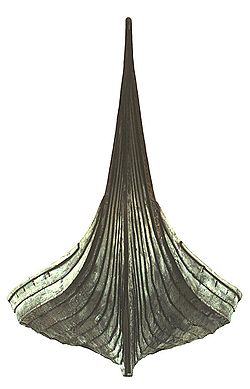
Polynesia
Polynesia is a subregion of Oceania, made up of over 1,000 islands scattered over the central and southern Pacific Ocean. The indigenous people who inhabit the islands of Polynesia are termed Polynesians and they share many similar traits including language, culture and beliefs...
centred on canoes, outriggers and multihull boats. By contrast, boats in Europe centred on framed and keeled monohulls.
The Scandinavia
Scandinavia
Scandinavia is a cultural, historical and ethno-linguistic region in northern Europe that includes the three kingdoms of Denmark, Norway and Sweden, characterized by their common ethno-cultural heritage and language. Modern Norway and Sweden proper are situated on the Scandinavian Peninsula,...
ns were building innovative boats millennia ago, as shown by the many petroglyph
Petroglyph
Petroglyphs are pictogram and logogram images created by removing part of a rock surface by incising, picking, carving, and abrading. Outside North America, scholars often use terms such as "carving", "engraving", or other descriptions of the technique to refer to such images...
images of Nordic Bronze Age
Nordic Bronze Age
The Nordic Bronze Age is the name given by Oscar Montelius to a period and a Bronze Age culture in Scandinavian pre-history, c. 1700-500 BC, with sites that reached as far east as Estonia. Succeeding the Late Neolithic culture, its ethnic and linguistic affinities are unknown in the absence of...
boats. The oldest archaeological find of a wooden Nordic boat is the Hjortspring boat
Hjortspring boat
The Hjortspring boat is a vessel designed as a large canoe, from the Scandinavian Pre-Roman Iron Age, that was excavated in 1921–1922 in Hjortspring Mose at Als in Sønderjylland...
, built about 350 BC. This is the oldest known boat to use clinker
Clinker (boat building)
Clinker building is a method of constructing hulls of boats and ships by fixing wooden planks and, in the early nineteenth century, iron plates to each other so that the planks overlap along their edges. The overlapping joint is called a land. In any but a very small boat, the individual planks...
planking, where the planks overlap one another. It was designed as a large canoe, 19 m long and crewed by 22–23 men using paddle
Paddle
A paddle is a tool used for pushing against liquids, either as a form of propulsion in a boat or as an implement for mixing.-Materials and designs:...
s. Scandinavians continued to develop better boats, incorporating iron
Iron
Iron is a chemical element with the symbol Fe and atomic number 26. It is a metal in the first transition series. It is the most common element forming the planet Earth as a whole, forming much of Earth's outer and inner core. It is the fourth most common element in the Earth's crust...
and other metal into the design, adding keel
Keel
In boats and ships, keel can refer to either of two parts: a structural element, or a hydrodynamic element. These parts overlap. As the laying down of the keel is the initial step in construction of a ship, in British and American shipbuilding traditions the construction is dated from this event...
s, and developing oars for propulsion. Another Nordic shipfind is the Nydam boat, found preserved in the Nydam Mose
Nydam Mose
Nydam Mose is an archaeological site located at Øster Sottrup, a town located in Sundeved, eight kilometres from Sønderborg, Denmark.-History:...
bog in Sundeved
Sundeved
Until January 1, 2007 Sundeved was a municipality in the former South Jutland County on the east coast of the Jutland peninsula in south Denmark. The municipality covered an area of 69 km², and had a total population of 5,298...
, Denmark
Denmark
Denmark is a Scandinavian country in Northern Europe. The countries of Denmark and Greenland, as well as the Faroe Islands, constitute the Kingdom of Denmark . It is the southernmost of the Nordic countries, southwest of Sweden and south of Norway, and bordered to the south by Germany. Denmark...
. It has been dendro dated
Dendrochronology
Dendrochronology or tree-ring dating is the scientific method of dating based on the analysis of patterns of tree-rings. Dendrochronology can date the time at which tree rings were formed, in many types of wood, to the exact calendar year...
to 310-320 AD. Built of oak, it is also clinker-built, is 23 metres long and was rowed by thirty men.

Norsemen
Norsemen is used to refer to the group of people as a whole who spoke what is now called the Old Norse language belonging to the North Germanic branch of Indo-European languages, especially Norwegian, Icelandic, Faroese, Swedish and Danish in their earlier forms.The meaning of Norseman was "people...
were pre-eminent on the oceans. They were skilled seamen and boat builders, with clinker-built boat designs that varied according to the type of boat. Trading boats, such as the knarr
Knarr
The Knarr is a Bermuda rigged, long keeled, sailing yacht designed in 1943 by Norwegian Erling L. Kristofersen. Knarrer were traditionally built in wood, with the hull upside down on a fixed frame, then attaching the iron keel after the hull was completed. The hull planks were manufactured with...
s, were wide to allow large cargo storage. Raiding boats, such as the longship
Longship
Longships were sea vessels made and used by the Vikings from the Nordic countries for trade, commerce, exploration, and warfare during the Viking Age. The longship’s design evolved over many years, beginning in the Stone Age with the invention of the umiak and continuing up to the 9th century with...
, were long and narrow and very fast. The vessels they used for fishing were scaled down versions of their cargo boats. The Scandinavia
Scandinavia
Scandinavia is a cultural, historical and ethno-linguistic region in northern Europe that includes the three kingdoms of Denmark, Norway and Sweden, characterized by their common ethno-cultural heritage and language. Modern Norway and Sweden proper are situated on the Scandinavian Peninsula,...
n innovations influenced fishing boat design long after the Viking period came to an end. For example, yole
Yole
A Yole is a clinker built boat that was used for fishing particularly in the north of Scotland. The best known of these is the Orkney Yole. They were rigged for sail or used as rowing boats. The Yole is of a Nordic design and closely related in shape to the Shetland Yoal and Sgoth Niseach of the...
s from the Orkney island of Stroma
Stroma, Scotland
Stroma is an island off the northern coast of the Scottish mainland. It is the more southerly of the two islands in the Pentland Firth between the Orkney Islands and Caithness. It is administratively part of Caithness , while its neighbour Swona, to the north, is part of the Orkney Islands...
were built in the same way as the Norse boats, as were the Shetland yoal
Yoal
The Yoal, often referred to as the Ness Yoal, is a clinker built craft used traditionally in the Shetland Islands. It is designed primarily for rowing, but which also handles well under her traditional square sail when running before the wind or on a broad reach...
s and the sgoth
Sgoth Niseach
A Sgoth or Sgoth Niseach is a traditional type of clinker built skiff with a dipping lug rig and a Lateen style sail built mainly in Ness. The boats were used as traditional fishing boats, particularly for line fishing, during the 19th century and up until the early half of the twentieth century...
s of the Outer Hebrides
Outer Hebrides
The Outer Hebrides also known as the Western Isles and the Long Island, is an island chain off the west coast of Scotland. The islands are geographically contiguous with Comhairle nan Eilean Siar, one of the 32 unitary council areas of Scotland...
..
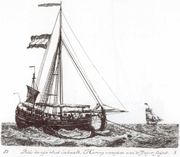
Herring
Herring is an oily fish of the genus Clupea, found in the shallow, temperate waters of the North Pacific and the North Atlantic oceans, including the Baltic Sea. Three species of Clupea are recognized. The main taxa, the Atlantic herring and the Pacific herring may each be divided into subspecies...
drifter
Drifter (fishing boat)
A drifter is a type of fishing boat. They were designed to catch herrings in a long drift net. Herring fishing using drifters has a long history in the Netherlands and in many British fishing ports, particularly in East Scottish ports....
that became a blueprint for subsequent European fishing boats. This was the Herring Buss
Herring Buss
A herring buss was a type of sea-going fishing vessel, used by Dutch herring fishermen in the 15th through early 19th centuries.The buss ship type has a long history...
, used by Dutch herring fishermen until the early 19th centuries. The ship type buss
Herring Buss
A herring buss was a type of sea-going fishing vessel, used by Dutch herring fishermen in the 15th through early 19th centuries.The buss ship type has a long history...
has a long history. It was known around 1000 AD in Scandinavia as a bǘza, a robust variant of the Viking longship. The first herring buss was probably built in Hoorn
Hoorn
-Cities :* Purmerend * Enkhuizen * Alkmaar * Amsterdam * Lelystad * Den Helder * Leeuwarden -Towns :* Edam...
around 1415. The last one was built in Vlaardingen
Vlaardingen
Vlaardingen is a town in South Holland in the Netherlands. It is located on the north bank of the Nieuwe Maas/Nieuwe Waterweg river at the confluence with the Oude Maas...
in 1841. The ship was about 20 meters long and displaced between 60 and 100 tons. It was a massive round-bilge
Bilge
The bilge is the lowest compartment on a ship where the two sides meet at the keel. The word was coined in 1513.-Bilge water:The word is sometimes also used to describe the water that collects in this compartment. Water that does not drain off the side of the deck drains down through the ship into...
d keel
Keel
In boats and ships, keel can refer to either of two parts: a structural element, or a hydrodynamic element. These parts overlap. As the laying down of the keel is the initial step in construction of a ship, in British and American shipbuilding traditions the construction is dated from this event...
ship with a bluff bow
Bow (ship)
The bow is a nautical term that refers to the forward part of the hull of a ship or boat, the point that is most forward when the vessel is underway. Both of the adjectives fore and forward mean towards the bow...
and stern
Stern
The stern is the rear or aft-most part of a ship or boat, technically defined as the area built up over the sternpost, extending upwards from the counter rail to the taffrail. The stern lies opposite of the bow, the foremost part of a ship. Originally, the term only referred to the aft port section...
, the latter relatively high, and with a gallery. The busses used long drifting gill nets to catch the herring. The nets would be retrieved at night and the crews of eighteen to thirty men would set to gibbing
Gibbing
Gibbing is the process of preparing salt herring , in which the gills and part of the gullet are removed from the fish, eliminating any bitter taste. The liver and pancreas are left in the fish during the salt-curing process because they release enzymes essential for flavor. The fish is then cured...
, salting and barrelling the catch on the broad deck. The ships sailed in fleets of 400 to 500 ships to the Dogger Bank
Dogger Bank
Dogger Bank is a large sandbank in a shallow area of the North Sea about off the east coast of England. It extends over approximately , with its dimensions being about long and up to broad. The water depth ranges from 15 to 36 metres , about shallower than the surrounding sea. It is a...
fishing grounds and the Shetland isles. They were usually escorted by naval vessels, because the English considered they were "poaching". The fleet would stay at sea for weeks at a time. The catch would sometimes be transferred to special ships (called ventjagers), and taken home while the fleet would still be at sea (the picture shows a ventjager in the distance).
.jpg)
Dogger (boat)
The dogger was a form of fishing boat, developed during the seventeenth century, that commonly operated in the North Sea. The dogger takes its name from the Dutch word dogger, meaning a fishing vessel operating a trawl...
, an early type of sailing trawler or longliner, which commonly operated in the North Sea
North Sea
In the southwest, beyond the Straits of Dover, the North Sea becomes the English Channel connecting to the Atlantic Ocean. In the east, it connects to the Baltic Sea via the Skagerrak and Kattegat, narrow straits that separate Denmark from Norway and Sweden respectively...
. The dogger takes its name from the Dutch word
Dutch language
Dutch is a West Germanic language and the native language of the majority of the population of the Netherlands, Belgium, and Suriname, the three member states of the Dutch Language Union. Most speakers live in the European Union, where it is a first language for about 23 million and a second...
dogger, meaning a fishing vessel which tows a trawl. Dutch trawling boats were common in the North Sea, and the word dogger was given to the area where they often fished, which became known as the Dogger Bank
Dogger Bank
Dogger Bank is a large sandbank in a shallow area of the North Sea about off the east coast of England. It extends over approximately , with its dimensions being about long and up to broad. The water depth ranges from 15 to 36 metres , about shallower than the surrounding sea. It is a...
. Doggers were slow but sturdy, capable of fishing in the rough conditions of the North Sea. Like the herring buss, they were wide-beamed and bluff-bowed, but considerably smaller, about 15 meters long, a maximum beam of 4.5 meters, a draught of 1.5 meters, and displacing about 13 tonnes. They could carry a tonne of bait, three tonnes of salt, half a tonne each of food and firewood for the crew, and return with six tonnes of fish. Decked areas forward and aft probably provided accommodation, storage and a cooking area. An anchor would have allowed extended periods fishing in the same spot, in waters up to 18 meters deep. The dogger would also have carried a small open boat for maintaining lines and rowing ashore.
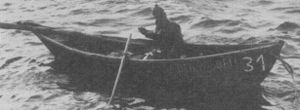
France
The French Republic , The French Republic , The French Republic , (commonly known as France , is a unitary semi-presidential republic in Western Europe with several overseas territories and islands located on other continents and in the Indian, Pacific, and Atlantic oceans. Metropolitan France...
bateau
Bateau
A bateau or batteau is a shallow-draft, flat-bottomed boat which was used extensively across North America, especially in the colonial period and in the fur trade. It was traditionally pointed at both ends but came in a wide variety of sizes...
type boat was a small flat bottom boat with straight sides used as early as 1671 on the Saint Lawrence River
Saint Lawrence River
The Saint Lawrence is a large river flowing approximately from southwest to northeast in the middle latitudes of North America, connecting the Great Lakes with the Atlantic Ocean. It is the primary drainage conveyor of the Great Lakes Basin...
. The common coastal boat of the time was the wherry
Wherry
A wherry is a type of boat that was traditionally used for carrying cargo or passengers on rivers and canals in England, and is particularly associated with the River Thames and also with the Broadland rivers of Norfolk and Suffolk. London passenger wherries evolved into the Thames skiff, a...
and the merging of the wherry design with the simplified flat bottom of the bateau resulted in the birth of the dory
Dory
The dory is a small, shallow-draft boat, about long. It is a lightweight and versatile boat with high sides, a flat bottom and sharp bows. They are easy to build because of their simple lines. For centuries, dories have been used as traditional fishing boats, both in coastal waters and in the...
. Antecdotal evidence exists of much older precursors throughout Europe. England, France, Italy, and Belgium have small boats from medieval periods that could reasonably be construed as predecessors of the dory.
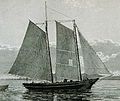
Dory
The dory is a small, shallow-draft boat, about long. It is a lightweight and versatile boat with high sides, a flat bottom and sharp bows. They are easy to build because of their simple lines. For centuries, dories have been used as traditional fishing boats, both in coastal waters and in the...
are small, shallow-draft
Draft (hull)
The draft of a ship's hull is the vertical distance between the waterline and the bottom of the hull , with the thickness of the hull included; in the case of not being included the draft outline would be obtained...
boat
Boat
A boat is a watercraft of any size designed to float or plane, to provide passage across water. Usually this water will be inland or in protected coastal areas. However, boats such as the whaleboat were designed to be operated from a ship in an offshore environment. In naval terms, a boat is a...
s, usually about five to seven metres (15 to 22 feet) long. They are lightweight versatile boats with high sides, a flat bottom and sharp bows, and are easy to build because of their simple lines. The dory first appeared in New England
New England
New England is a region in the northeastern corner of the United States consisting of the six states of Maine, New Hampshire, Vermont, Massachusetts, Rhode Island, and Connecticut...
fishing towns sometime after the early 18th century. The Banks dories
Banks dory
The Banks dory, also known as the Grand Banks dory, is the most common variation of the family of boats known as dories. They were used as traditional fishing boats from the 1850s on the Grand Banks of Newfoundland. The Banks dory is a small, open, narrow, flat-bottomed and slab-sided boat with a...
appeared in the 1830s. They were designed to be carried on mother ship
Mother ship
A mother ship is a vessel or aircraft that carries a smaller vessel or aircraft that operates independently from it. Examples include bombers converted to carry experimental aircraft to altitudes where they can conduct their research , or ships that carry small submarines to an area of ocean to be...
s and used for fishing cod
Cod
Cod is the common name for genus Gadus, belonging to the family Gadidae, and is also used in the common name for various other fishes. Cod is a popular food with a mild flavor, low fat content and a dense, flaky white flesh. Cod livers are processed to make cod liver oil, an important source of...
at the Grand Banks
Grand Banks
The Grand Banks of Newfoundland are a group of underwater plateaus southeast of Newfoundland on the North American continental shelf. These areas are relatively shallow, ranging from in depth. The cold Labrador Current mixes with the warm waters of the Gulf Stream here.The mixing of these waters...
. Adapted almost directly from the low freeboard, French river bateaus, with their straight sides and removable thwarts, bank dories could be nested inside each other and stored on the decks of fishing schooners, such as the Gazela Primeiro
Gazela
Gazela is a 1901 wooden tall-ship homeported in Philadelphia, Pennsylvania. She serves as the maritime goodwill ambassador for the City of Philadelphia, the Commonwealth of Pennsylvania, and the Ports of Philadelphia and Camden, New Jersey...
, for their trip to the Grand Banks fishing grounds.
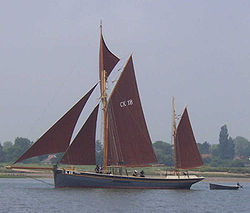
Brixham
Brixham is a small fishing town and civil parish in the county of Devon, in the south-west of England. Brixham is at the southern end of Torbay, across the bay from Torquay, and is a fishing port. Fishing and tourism are its major industries. At the time of the 2001 census it had a population of...
. These elegant wooden sailing boats spread across the world, influencing fishing fleets everywhere. Their distinctive sails inspired the song Red Sails in the Sunset
Red Sails in the Sunset (song)
"Red Sails in the Sunset" is a popular song.Published in 1935, its music was written by Hugh Williams with lyrics by prolific songwriter Jimmy Kennedy...
, written aboard a Brixham sailing trawler called the Torbay
Torbay
Torbay is an east-facing bay and natural harbour, at the western most end of Lyme Bay in the south-west of England, situated roughly midway between the cities of Exeter and Plymouth. Part of the ceremonial county of Devon, Torbay was made a unitary authority on 1 April 1998...
Lass. In the 1890s there were about 300 trawling vessels there, each usually owned by the skipper of the boat. Several of these old sailing trawlers have been preserved.
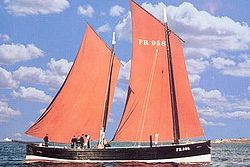
Smack (ship)
A smack was a traditional fishing boat used off the coast of England and the Atlantic coast of America for most of the 19th century, and even in small numbers up to the Second World War. It was originally a cutter rigged sailing boat until about 1865, when the smacks became so large that cutter...
were used in the Thames Estuary and off East Anglia
East Anglia
East Anglia is a traditional name for a region of eastern England, named after an ancient Anglo-Saxon kingdom, the Kingdom of the East Angles. The Angles took their name from their homeland Angeln, in northern Germany. East Anglia initially consisted of Norfolk and Suffolk, but upon the marriage of...
, while trawlers and drifters were use on the east coast. Herring
Herring
Herring is an oily fish of the genus Clupea, found in the shallow, temperate waters of the North Pacific and the North Atlantic oceans, including the Baltic Sea. Three species of Clupea are recognized. The main taxa, the Atlantic herring and the Pacific herring may each be divided into subspecies...
fishing started in the Moray Firth
Moray Firth
The Moray Firth is a roughly triangular inlet of the North Sea, north and east of Inverness, which is in the Highland council area of north of Scotland...
in 1819. The Manx nobby was used as a herring drifter
Drifter (fishing boat)
A drifter is a type of fishing boat. They were designed to catch herrings in a long drift net. Herring fishing using drifters has a long history in the Netherlands and in many British fishing ports, particularly in East Scottish ports....
around the Isle of Man
Isle of Man
The Isle of Man , otherwise known simply as Mann , is a self-governing British Crown Dependency, located in the Irish Sea between the islands of Great Britain and Ireland, within the British Isles. The head of state is Queen Elizabeth II, who holds the title of Lord of Mann. The Lord of Mann is...
, and fifie
Fifie
The Fifie is a design of sailing boat developed on the east coast of Scotland. It was a traditional fishing boat used by Scottish fishermen from the 1850s until well into the 20th century...
s were used as herring drifters
Drifter (fishing boat)
A drifter is a type of fishing boat. They were designed to catch herrings in a long drift net. Herring fishing using drifters has a long history in the Netherlands and in many British fishing ports, particularly in East Scottish ports....
along the east coast of Scotland from the 1850s until well into the 20th century.
See also
- Fishing vessels
- GableboatGableboatA gableboat is a traditional Norwegian boat mainly used for fishing with a seine. It is usually built by clinker method pine on oak framework. They are robust boats that can carry big loads, but are still swift sailers...
- Medieval European maritime cultureMedieval European maritime cultureThe medieval maritime culture began with the remnants of the naval tradition of the Roman Empire, included the technological advances that enabled the Vikings to colonize North America in 982, suffered tremendously during the crises of the 14th century, prospered to serve the European demand for...
- Maritime history of the United KingdomMaritime history of the United KingdomThe Maritime history of the United Kingdom involves events including shipping, ports, navigation, and seamen, as well as marine sciences, exploration, trade, and maritime themes in the arts from the creation of the kingdom of Great Britain as a unified sovereign state on 1 May 1707 in accordance...
Reading
- Adney ET, Chappelle HI and McPhee J (2007) Bark Canoes and Skin Boats of North America Skyhorse Publishing. ISBN 1-60239-071-1
- Gerr, Dave (1995) The Nature of Boats: Insights and Esoterica for the Nautically Obsessed McGraw-Hill Professional. ISBN 978-0-07-024233-3
- Smylie, Michael (1999) Traditional Fishing Boats of Britain & Ireland: Design, History and Evolution. Adlard Coles Nautical. ISBN 978-1-84037-035-5
- Traung, Jan-Olaf (1960) Fishing Boats of the World 2 Fishing News (Books) Ltd. Download PDF (99MB)
- Traung, Jan-Olaf (1967) Fishing Boats of the World 3 Kiefer Press. ISBN 978-1-4437-6711-8. Download PDF (56MB)
- Vigor, John (2004) The Practical Encyclopedia of Boating: An A-Z Compendium of Seamanship, Boat Maintenance, Navigation, and Nautical Wisdom McGraw-Hill Professional. ISBN 978-0-07-137885-7
- Woodman, Richard (1998) The History of the Ship: The Comprehensive Story of Seafaring from the Earliest Times to the Present Day, Lyons Press. ISBN 978-1-55821-681-5
External links
- The Uros People at GlobalAmity.net
- http://video.google.com/videoplay?docid=5068208647467827700&hl=enVideo tour of UrosUrosThe Uros are a pre-Incan people who live on forty-two self-fashioned floating islands in Lake Titicaca Puno, Peru and Bolivia. They form three main groups: Uru-Chipayas, Uru-Muratos and the Uru-Iruitos...
floating fishing villages] - Uros Indian Culture - Home
- Floating islands on Google Maps
- Trujillo, The Golden Steeds of Huanchaco
- Indigenous boats: Small craft outside the Western tradition
- A history of shipbuilding in Newfoundland
- Jangadeiros, the fishermen in the northeastern Brazil

